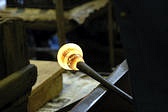Why Does Glass Sparkle?
 In some form or shape, we get the question of what makes glass sparkle a lot. The sparkle, or refractory quality, of glass has to do with two elements: the chemical nature of the glass and the design of the glass itself.
In some form or shape, we get the question of what makes glass sparkle a lot. The sparkle, or refractory quality, of glass has to do with two elements: the chemical nature of the glass and the design of the glass itself.
The Chemistry of “Sparkle”
Let’s start by sharing that in glass, there is this thing called the “refractive index.” Glass that seems to glitter against the light is most often due to the inclusion of lead oxide – commonly called lead – which makes it the most refractive on our index. Back in the day (say, the 17th century), the word “crystal glass” was used to describe a decorative glass that was cut to brilliance and used in fine objects like tableware, chandaliers and other decorative home elements. (Crystal is from the artists of Venice who used the Italian word “cristallo. Technically glass isn’t crystal because it doesn’t have the required crystaline structure. But no one checks the science, so we still use the phrase “crystal glass.”) On the opposite end of the index, you have clear, manufactured glass (think of the vase your Valentine’s Day flowers come in) which has been stripped of all the iron, lead, and other impurities naturally found in glass. It has a lower refractive quality, that is to say it doesn’t sparkle quite like the Waterford vase from your grandmother.
The base ingredient in glass is sand and that plays a big role in sand’s final quality and color. If we were to take sand from the beach and use it in our glass recipe, we’d end up with glass slightly tinted green or blue because of the chemical components of the sand on the beach. Here in the U.S. most of the sand used in glass production is harvested from Mississippi, Pennsylvania or West Virginia. All three states offer great quality sand with fewer impurities, which makes a great base for any glass production.
But, believe it or not, impurities actually can help raise glass’ natural tendency to sparkle. So yes, you want your to be a little bit “dirty” if you want it to sparkle.
The Design of “Sparkle”
While the Venetian glass artists were off about calling glass “crystal” they knew more than a few things about design. By blowing, etching, cutting, and designing the glass in certain ways, they enhanced glass’ natural tendency to sparkle. By adding in beautiful cut-in designs to tableware, or creating uniform glass pieces designed to catch light in a chandelier, they were using their skills to increase the light captured and refracted back to your admiring eyes. With stained glass or other glass elements in windows or doors, much is made in how the external light will hit the design during the day, as well as during the year. (Remember, our axis shifts, so light at mid-morning is different in winter than it is in summer.) This design-sense is why people who work with glass are truly artists.
At BottlesUp, we use both chemistry and design to amp up the sparkle factor in our glass water bottles. Recyled glass has more of the natural chemical compounds found in glass, like iron, that keep it from being too stripped and therefore lower on the refractory index. Our bottles aren’t manufactured either, their created by skilled artisans using ancient techniquest in a modern facility. To enhance this natural beauty, we designed a slight “hammered” effect into the glass to catch the light and help it gleam. Here’s the great part: with a BottlesUp glass water bottle you get a functional water bottle that’s good for your health and the environment, you get a sparkly, beautiful object.
Why Does Glass Sparkle? Read More »